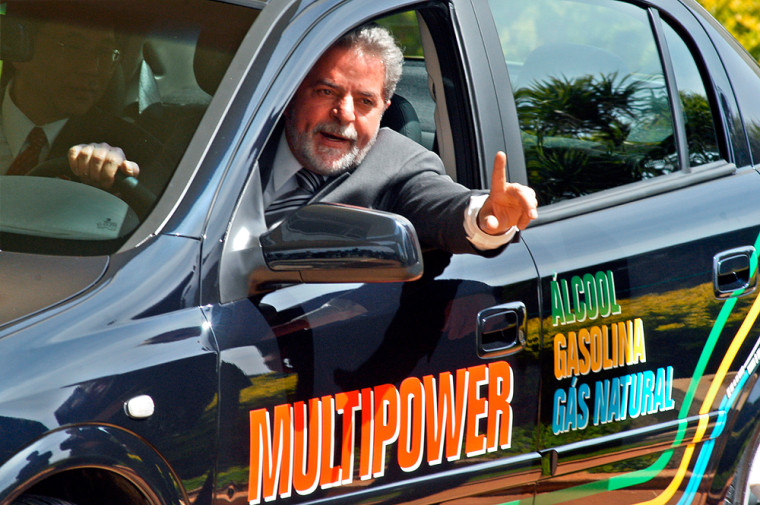If it wasn’t for the TotalFlex logo on the new Gol subcompacts leaving a sprawling Volkswagen plant, the shiny cars would be indistinguishable from millions already on the road across Latin America.
But these Gols and other models produced by Fiat SpA and General Motors Corp. have modified engines that, given the rising price of oil, are making Brazilians smile at the gas pumps. They run on gasoline, alcohol or any combination of the two and now represent nearly 20 percent of the new cars sold in Brazil.
With alcohol — also called ethanol — cleaner and selling at half the price of gas in South America’s largest country, Brazilians who have bought 200,000 “flex-fuel” cars since their launch last year say deciding which fuel to use is a no-brainer.
“Alcohol, all the time,” said office manager Roseli Santana as she filled up her 2004 subcompact GM Montana pickup at a Shell station in Sao Paulo, Brazil’s largest city and home to 5 million cars. “I was using 52 reals ($17) of gas every week, now I’m paying 30 reals ($10) for the same amount, except it’s alcohol.”
Export goal
Brazil hopes to export flex-fuel cars and technology around the world, and auto industry executives say interest from abroad is increasing. So far, Volkswagen has hosted delegations from Australia, China, England, India, Japan and South Africa.
“They want to know how it works,” said Joao Alvarez Jr., the top engineering executive for Volkswagen’s Brasil’s flex-fuel car lineup, which has the biggest market share. “Gasoline is going to run out someday, everyone knows that.”
Engine and assembly line changes to make flex-fuel cars aren’t complicated, though the cars come outfitted with a tiny gas-only tank under the hood smaller than a windshield wiper fluid reservoir. It’s used to start the car on cold days just for a moment before automatically switching back to alcohol or whatever is in the main tank.
But mass exports of flex-fuel cars aren’t likely in the near future, because no other country has an alcohol fuel production and distribution system as advanced as Brazil’s. Virtually all the country’s service stations offer alcohol.
1970s origin
The idea for non-gas powered cars goes back to the 1970s fuel crisis, when Brazil’s economy nose-dived, prompting the country’s military dictatorship to launch a campaign to wean the country from expensive, imported oil.
Government subsidies helped fund the design and manufacture of alcohol-only cars. They also supported a vast industry near Sao Paulo to cultivate sugarcane and refine it into alcohol, and an alcohol distribution network that spans a country nearly the size of the continental United States.
Millions of Brazilians switched to the alcohol-only cars in the 1980s, but a 1989 shortage of alcohol left enraged motorists unable to fill up and drive their cars. Falling gas prices in the 1990s added to the end of the country’s affair with alcohol-only cars. Last year’s sales of alcohol-only cars represented only 3.5 percent of new vehicle sales.
But flex-fuel cars sales took off after the vehicles made it to show rooms last September, totaling 50,000 through the end of 2003. An additional 150,000 were sold from January through June, the latest period for which figures are available.
Infrastructure abroad needed
Other nations like the United States are promoting a fuel mix consisting of 85 percent alcohol and 15 percent gas, but experts say it will take years — if not decades — for true flex-fuel cars to be sold outside Brazil.
“The problem with these flex-fuel vehicles is they need to meet with an established infrastructure,” said Cristoph Berg, a commodities analyst with F.O. Licht in Germany. “In the case of Brazil, the fuel was there first.”
Some American cars can run on the alcohol-gasoline mix, known as E85, but it’s hard to find at the pumps. Most of the efforts of carmakers in the United States on alternatives to gas has been focused on making and marketing hybrid cars with gas and electric engines.
Flex-fuel cars will grab an increasing share of the Brazilian auto market even if gas prices fall because buyers get a viable fuel choice they never had before, said Joao Leite, owner of the Autoinforme Web site focusing on Brazil’s auto industry .
“If gas and alcohol are the same price, I’m still going to go for the flex because you never know what will happen in a year or two,” he said. “You can’t lose with a flex car.”
Natural gas version
Other big automakers, like Ford Motor Co., plan to start selling Brazilian flex-fuel cars this year. And GM recently upped the ante on fuel choice for Brazilians, offering a flex-fuel car that also runs on natural gas, widely available at the pumps in Brazil’s biggest cities.
Brazilian drivers for years have hired mechanics to install natural gas conversion kits on their cars. But GM’s compact Astra is the first to come with natural gas as a factory-installed option, with an extra tank for the fuel in the trunk.
After buying her flex-fuel pickup in January for $8,300, Santana experimented with mixes of alcohol and gas before settling on pure alcohol. The vehicle’s performance is the same on both types of fuel, she says, though it gets slightly fewer miles to the gallon with alcohol. So far, she’s saved about $200 on fuel.
Three of Santana’s friends bought flex-fuel cars after she told them she will never go back to a gasoline-powered car, and will only buy gas for her pickup if the price drops significantly.
“I was a little worried about using the alcohol, but there’s really no difference,” Santana said. “If it ends up costing the same price, maybe I’ll just mix the two.”
